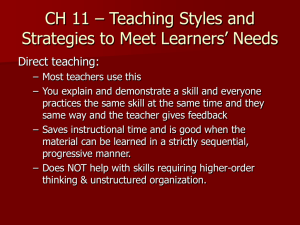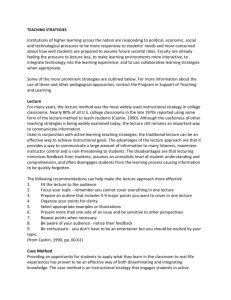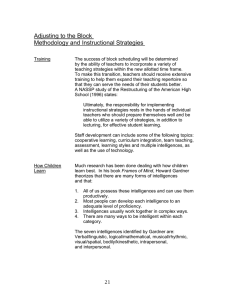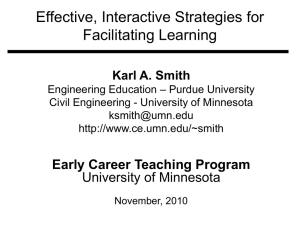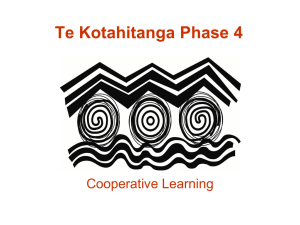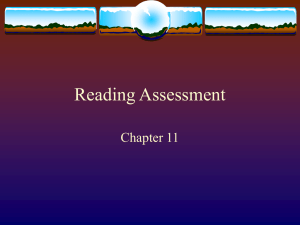ch. 10 pres.3 final
advertisement
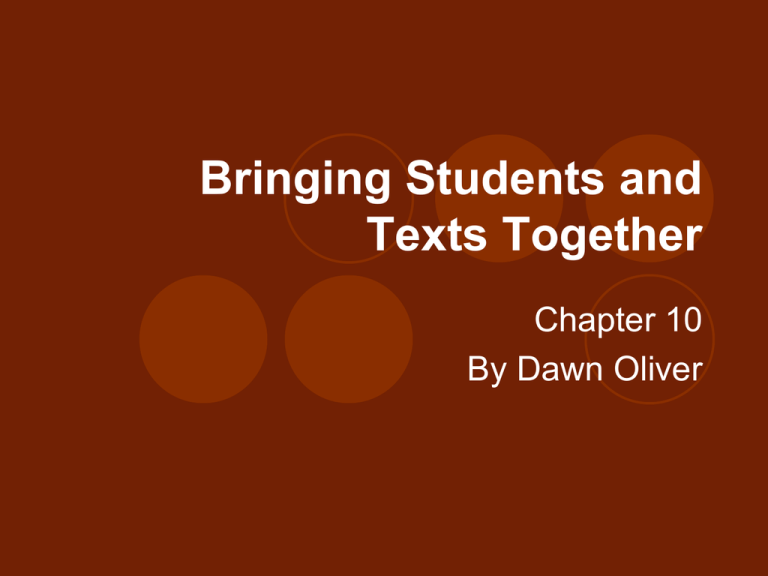
Bringing Students and Texts Together Chapter 10 By Dawn Oliver Chapter 10 Overview SOCIOCULTURAL CONTEXT FOR READING COMPREHENSION - Reading Engagement - What Affects Reading Engagement? DESIGNING AND PLANNING TEXT LESSONS - B-D-A instructional framework DESIGNING AND PLANNING UNITS OF STUDY - Thematic/Conceptual Unit Structure Using: a. Inquiry/Research Emphasis b. Multiple Text Emphasis DESIGNING AND PLANNING COLLABORATIVE INTERACTIONS a. Cooperative Learning Groups b. Small-Group Processes TEXT ACTIVITY Reading Comprehension READER SOCIO-CULTURAL CONTEXT AFFECTS WHAT HAPPENS IN CLASSROOM: 1. What types of learning that happens 2. Environment of classroom 3. amount of comprehension of content ENGAGED READERS and WRITERS ARE: READER Socially Interactive Motivated Knowledgeable ACTIVITY strategic TEXTS Reading is a Purposeful Activity Reading Activities take into account: Purposes for reading Processes that engage readers to accomplish tasks at hand Consequences of activity DESIGNING AND PLANNING TEXTCENTERED LESSONS Connect content area learning Provide a blueprint for action Engaged learning is often the result of well-designed and well-planned lessons and units of study LESSON PLAN FORMATS Vary between school districts Align with same State standards or local standards Effective Lessons = Well Planned lessons We are learning lesson plans extensively, so I will not cover the material much. B-D-A Instructional Framework Instructional Sequence Rationale Before Reading To establish purpose, activate background, sustain motivation, and provide direction During reading To guide an active search for meaning After Reading To extend and elaborate ideas from the text B-D-A Instructional Framework Before Reading During Reading After Reading Guidelines that guide the search for meaning during reading. Students need to be shown how to think with texts. Motivating student interest in learning BEFORE READING Build and activate prior knowledge for a lesson - Asking questions like: What does yesterday’s lesson have to do with today’s? Presenting key vocabulary and concepts 3 key questions: 1. What keywords will students need to understand 2. Are all the terms equally important? 3. Which new words carry heavy concept loads? DURING READING Activities created to help students recognize the important parts of a text assignment AFTER-READING After reading activities create a structure that refines emerging concepts They also help clarify and elaborate on ideas encountered before and during reading Examples of activities for B-D-A 1. 2. 3. 4. 5. 6. Admit Slips Selected Reading Guides Reading Road Map Guide Cause-Effect Study Guide Compare-Contrast Study Guide And more… What constitutes a text? Lets Brainstorm: Types of texts Text books Television shows Movies Novels Video games internet Others… MULTIPLE-TEXT EMPHASIS See figure 10.10 (p. 360) Extends Conceptual base through differentiated assignments We are living in the age of boundless information To learn and craft researching techniques, one needs to research various textbooks and forms of text Get different view points on same subject or different approach to describe a technique or subject GOING BEYOND THE TEXTBOOK Inquiry/Research Emphasis in Unit Study - Best if students are guided through process - Students use human resources to conduct inquiries , like interviews - Students gather, evaluate, and synthesize data from a variety of sources to communicate their discoveries in ways that suit their purpose or audience - Fosters variety of reading to answer student initiated question STAGES OF INQUIRY PROCESS 1.Searching for Ideas 2.Gathering and Sifting information 3.Finding a Focus 4.Building Momentum 5.Rethinking and Revising 6.Reaching an Audience COOPERATIVE LEARNING STRATEGIES 1.Jigsaw Groups 2.STAD – Student Teams Achievement Divisions 3.Learning Circles 4.Group Investigations 5.Group Retellings SMALL GROUP PROCESSES (things that affect learning comprehension) 1.Group Size 2.Group Composition 3.Group Goals and Tasks 4.Positive Interdependence 5.Group Roles and Division of Labor DESIGNING AND PLANNING COLLABORATIVE INTERATIONS Goals of Cooperative Learning: 1.To foster collaboration in a classroom context 2.To develop students’ self-esteem in the learning process 3.To encourage the development of positive group relationships BRIEF DESCRIPTION OF COOPERATIVE LEARNING STRATEGIES JIGSAW 1. The class is divided into heterogeneous groups of 3-6 members 2. Each member of the group is required to become an expert of one topic to teach the other members of the group 3. After each member researches or comes up with a list of information need to teach the other members, the members meet in temporary topic groups to share their findings and knowledge 4. Members return to their original groups to teach the group what they learned. STAD 1. Teacher introduces a topic of study to whole class, presents new information, then divides the class into heterogeneous 4-member groups of high-average-and low achieving students 2. The goal of the team is to master the content presented 3. Team members help each other by discussing the material, problem solving, comparing answers, etc. 4. Students will take periodic quizzes or assessments given by teacher following the team study. LEARNING CIRCLES (Similar to STAD) - General name for cooperative interdependence activities Examples: (discussed in previous chapters) 1. 2. 3. 4. Brainstorming Prediction Problem solving Mapping 5. Study strategies GROUP INVESTIGATION Is pretty much how it sounds. It is a group research project and presentation Group Retellings Show the importance of conceptually related readings. Process: 1. Students of the group each have the same topic, but read from different sources 2. Groups are mixed abilities 3. Everyone comes back together as a group to discuss findings or they can come up with a group consensus of one definition or explanation as a group collaborating their findings. 4. Everyone should take turns listening to each others findings. BRIEF DESCRIPTION OF SMALL GROUP PROCESSES GROUP SIZE Should be just large enough to include all the skills necessary to solve a problem or complete a task. GROUP COMPOSITION Factors that effect choice of Group Composition: Experimental and social backgrounds Interests Attitudes Personality All contribute greatly to success of a cooperative group GROUP GOALS and TASKS Conditions of task and Criteria for task(s) need to be clearly explained so all group members understand How goals and paths to the completion of task(s) are perceived can affect the amount and quality of team member(s) involvement POSITIVE INTERDEPENDENCE Crucial to group cohesiveness Keeps groups working cooperatively, not competitively Group members need to work together rather than independently Small group learning has been proven to have positive effects on academic achievement and social relationships GROUP ROLES and DIVISION OF LABOR Division of labor is important in group activities It is important that all team members are accountable for their assigned tasks THAT’S ALL FOLKS!!! ACTIVITY-STRATEGY DEMO of GROUP RETELLING 1. Put students in groups of 4 persons each 2. Each member in the group has same topic 3. Direct students to study their specific topic 4. Finally, have students return to their original groups to teach others in the group of their mastery of the subject. 5. Students should take turns to listen to each others comments before giving input and other ideas Possible Topics for Mathematical Problem Solving 1.Drawing a Picture 2.Breaking up the Question 3.Substituting Simpler Numbers 4.Making a Table 5.Finding and Deleting Unnecessary Information PROMPT SHEET: Things to think about while researching: Description of strategy’s What type of problem solving strategy is it? Give examples of methods What type of problems would this particular method be useful?

